I posted recently this same content at SCN and I decided to post it here too. It goes a little bit away of the main focus of this blog (SAP Brazil Localization and S/4HANA, HANA, In-Memory and etc.) but it is still SAP and I meant to help.
If you like it, please, go to SCN and rate my post there. Five starts are appreciated 🙂
The Links for SCN posts are:
LE-TRA – Config Guide for Shipment & Shipment Cost Document – Part I
LE-TRA – Config Guide for Shipment & Shipment Cost Document – Part II
LE-TRA – Config Guide for Shipment & Shipment Cost Document – Part III
I wrote this configuration guide for Logistics Execution Transportation (LE-TRA) sometime ago for my own reference and kept updating it while my company was changing the process, projects were going on, merges, acquisitions and etc. This document is more focused on freight payments and Shipment Cost Document, but it has a nice overview of all configuration required until a Shipment Cost Document can be created. This includes of course, the shipment configuration in a higher level.
I hope you enjoy reading as much as I enjoyed writing and I hope you find this helpful.
Index / Content
- SAP Language
- Transportation – Shipment
- Master Data
- Maintain Transportation Planning Point
- Define Routes
- Define Modes of Transport
- Define Shipping Type
- Defining Transportation Connection Point
- Defining Transportation Zones
- Define Transportation Groups
- Setting up Weight Groups
- Define Routes and Assigning Routes
- Definition of routes
- Maintain Stages for all Routes
- Determining Routes
- Route Determination in Sales Order
- Configuration of Shipments
- Maintain Transportation Relevance
- Set Up Transportation Planning Points
- Define Shipment Type
- Transportation – Shipment Cost Document
- Shipment Cost Document Structure
- Define Date Rules
- Define and Assign Tariff Zones
- Define and Assign Activity Profile
- Define Shipment Cost types
- Define Item Categories:
- Assign Shipment Cost Type and item categories
- Maintain Shipment cost relevance and default for shipment cost type
- Define shipment cost relevance for shipment type
- Pricing
- Define and assign shipping type procedure group
- Define and assign item procedure group
- Define Service Agent Procedure Group for Shipment Costs
- Maintain Price Procedure
- Define Pricing Procedure Determination for Shipment Costs
- Maintain Condition Type
- Settlement
- Assign Purchasing Data
- Account Determination
- Group Together Valuation Areas
- Define Valuation Classes
- Automatic G/L account Determination
- Automatic determination of CO assignments
- Business Process Procedure
- Create transportation condition records
- Create Delivery Document
- Create Shipment Document
- Creating Shipment Cost Document & Cost Settlement
- Effects of Shipment cost settlement and related documents
- User-Exits
- BADIs
SAP Language
Here are some common terms that you will see while dealing with LE-TRA in SAP:
Forwarding Agent / Service Agent – Agent who provides the transportation, also known as Carrier or Logistic Service Provider. This is usually (but not always) the vendor who will be paid by the freight service.
Routes – The route is a component of LE-SHP and plays an important role in the Shipping process creation and planning, determining itinerary (the leg or stage in the shipment), determines Means of Transport, like truck, train, plane or ship and they usually carry a departure point information (e.g. Shipping point) and Destination Point (port of destination, customer and etc).
Handling Unit – The handling unit is the packaging in the shipment that will contain the materials/products that are been transported. For example, in a shipment you may have all your products packed in a Container, then the container is your handling unit. However, depending on the size of the shipment you may have multiple containers and those containers are loaded in a big vessel, then besides the containers, you will also have a vessel as a packing unit, or a handling unit. The handling unit in a shipment can also be called “Equipment”. The Handling Unit plays an important role in the shipment cost calculation, they are represented as sub-items in the SCD items.
Shipment – The Shipment document containing details based on predecessor deliveries, including who are the service agents, the routes, what are the stages, and the deadlines for planning and execution times. This document is the pre-requisite to the Shipment Cost Document.
Shipment Type – Shipment type contain primary settings to the shipment document such like: the Direction (inbound or Outbound), number range, partner information, stage determination procedure and etc.
Shipment Cost Document – This document is created subsequent to the Shipment, using this document as reference. The Shipment Cost Document (SCD) contains the necessary data to pay the service agent (agreed rates, price, invoice party and etc.) and also accounting data (G/L Account, Cost Center and etc.) This document when created correct will be used in most of the times to trigger an accrual in the system.
Shipment cost type and item categories – Shipment cost types and item categories carry settings to control the shipment cost document, like number range, status requirements for the shipment documents, shipment costing settings, shipment transfer/settlement settings.
Rates – Rates are loaded in the system via Condition Technique (using condition types predefined) and they are carried over to the SCD when the document is created. The rates can be created in more than one condition to the same document, for example if you want breakdown the agreed freight cost with the service agent between what is freight service, what is toll, what is fuel surcharge and etc.
Transportation Planning Point – Aka. TPP, it is an organizational level in Logistics that is responsible for planning and processing shipments. They can also be represented by a group of people inside of the organization, for example, TPP for mode Ocean, TPP for mode Truck and etc, to segregate the Logistics Planners and also perform sap security segregation. Each Shipment is assigned to a TPP.
Transportation – Shipment
Master Data
- Business Partner Master Data > They are the Service-Agents (Freight-Forwarder), Ship-to, Sold-to, Bill-to, Brokers and Customs Agents, Carriers, Customers, Vendors and etc.
- Material master data > You can’t have a shipment without products (material). The material master data willdefine the products that will be transported and also they represents the handling unit (packaging material). All products and materials transported using the transportation system (shipments) must have a material master data.
- Organizational master data > To the whole process flow from Sales Order to Delivery, Shipping, Shipment Cost Document, Invoice Payment and etc., system will need to have the following Organization Level created and properly assigned: Business areas, Sales Organization, Sales Area, Distribution Channels, Transportation Planning Points, Plants, Routes, Shipping Points, Purchase Organization, Purchase Group, Controlling Area and etc.
Maintain Transportation Planning Point
| TCODE | SPRO or SM30 |
| Path | SPRO > Enterprise Structure > Definition > Logistics Execution > Maintain transportation planning point |
| Table/View | V_TTDS |
Also called “TPP”, it is an organizational level in Logistics that is responsible for planning and processing shipments. They can also be represented by a group of people inside of the organization, for example, TPP for mode Ocean, TPP for mode Truck and etc, to segregate the Logistics Planners and also perform sap security segregation. Each Shipment is assigned to a TPP.
A Transportation Planning point can be responsible for multiple Shipping Points and the Shipment is assigned to one transportation planning point only, which can contain multiple deliveries assigned and those may belong to multiple shipping points that belongs to the same transportation planning point:
In the same SPRO path, you assign the transportation planning point to a company code, as per screenshot above. This assignment is required to when the Shipment triggers a Shipment Cost Document, then the freight costs calculated are posted to the proper company code (see more below Shipment Cost Document and Settlement details).
Define Routes
The route is a component of LE-SHP and plays an important role in the Shipping process creation and planning, determining itinerary (the leg or stage in the shipment), determines Means of Transport, like truck, train, plane or ship and they usually carry a departure point information (e.g. Shipping point) and Destination Point (port of destination, customer and etc)..
| TCODE | 0VTC |
| Path | SAP Easy Access > Logistics > Logistics Execution > Master Data > Transportation > Routes > Define Routes > Define Routes and Stages |
| Table/View | TVRO |
To create the routes, you need to do the following:
- Inform the modes of transport that will be assigned to that route
- Inform the shipping types that are allowed in that route (for example, you will not allow ocean in a route that is from New York 5th Avenue to New York Broadway St.)
- Inform the transportation connection points and maintain the relevant data on the detail screen
- Inform routes and route stages
You can also maintain the route stages for several stages.
Define Modes of Transport
| TCODE | 0VTB |
| Path | SPRO > Logistics Execution > Transportation > Basic Transportation Functions > Routes > Define Routes > Define Modes of Transport |
| Table/View | V_TVTR_COM |
- Define which modes of transport are relevant to your process
- Assign the mode of transport to a mode-of-transport type. The mode-of-transport type is responsible for classification of modes of transport in DG management.

Define Shipping Type
Here you will inform what are the shipping types and their mode of transport. See below in the screenshot some example of Shipping Types. They are suggestions only. Create them according to your business requirements.
| TCODE | 0VTA |
| Path | SPRO > Logistics Execution > Transportation > Basic Transportation Functions > Routes > Define Routes > Define Shipping types |
| Table/View | V_T173_COM |
To create The Shipping Types you have to do the following steps:
- Define the shipping types
- Assign one or more modes of transport to each shipping type
- Assign the shipping types to a shipping type group. (This is important to automatically determine the freight pricing procedure that will calculate the freight costs and freight rates, see more below in the Shipment Cost Document Section).
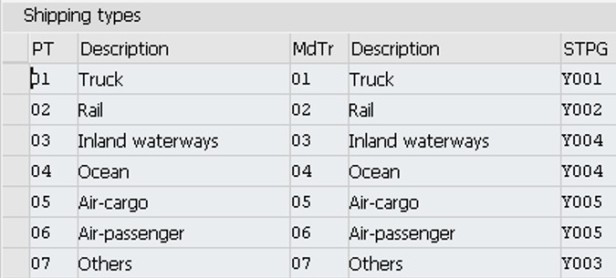
Defining Transportation Connection Point
TCP is the place where goods are received, issued, re-shipped or processed. Those processes can include activities like customs clearance or railway car cleaning, railway station for example. For each TCP, you can define the type (for example: load transfer point, airport or border), who is the responsible customs office, calendar and stopover time. You can also refer it to a plant or shipping point, a customer or vendor or to an address.
| TCODE | 0VTD |
| Path | SPRO > Logistics Execution > Transportation > Basic Transportation Functions > Routes > Define Routes > Define Transportation Connection Point |
| Table/View | V_TVKN_COM |

Defining Transportation Zones
It is where you will specify all the regions that you plan to cover with your routes. The routes will be from a departure zone to a destination zone.
There are three kinds of transportation zones:
• Direct zone > Can be allocated to explicit locations
• Postal code zone > Contains all locations corresponding to the valid postal code areas of a particular country
• Region zone > is defined by entering a country and region, and contains all locations in that region
You can also have a mixed zone which is a combination of the types above.
| TCODE | OVR1 |
| Path | SPRO > Logistics Execution > Shipping > Basic Shipping Functions > Routes > Route Determination > Define Transportation Zones |
| Table/View | V_TZONE |
The zones you set up here will be used in the master data. The location of each customer and vendor will be identified using the Transportation Zone field on the Address tab in the customer (or vendor) master record.

You can also specify the zones for each of your shipping points here:
| TCODE | OVL7 |
| Path | SPRO > Logistics Execution > Shipping > Basic Shipping Functions > Routes > Route Determination > Maintain Country and Transportation Zone for Shipping Point |
| Table/View | V_TVST_RF |
Select the shipping point, and specify the country and transportation zone.

Define Transportation Groups
The transportation group specify the materials that will have similar requirements for transportation. For example, you can group products that are bulk or non-bulk, Pallet or Box and etc. You assign those groups in Material Master Records.
| TCODE | OVSY |
| Path | SPRO > Logistics Execution > Shipping > Basic Shipping Functions > Routes > Route Determination > Define Transportation Groups |
| Table/View | V_TTGR |
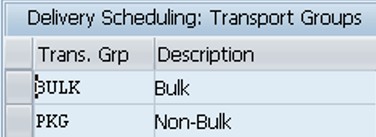
Setting up Weight Groups
If the weight of the delivery plays a role in route determination, you can set up weight strategy here.
| TCODE | OVS8 |
| Path | SPRO > Logistics Execution > Shipping > Basic Shipping Functions > Routes > Route Determination > Define Weight Groups |
| Table/View | VC_TVLG |
- First you need to Maintain Weight Group, creating a new weight group with the corresponding description.
- Then you need to maintain details for Weight Group where you will specify the maximum weight that is allowed in each weight group and then when the delivery is created, SAP will take the weight in consideration and determine the right route based on the rules you created. If you decided not to use this feature, the route determination will take place in the sales order and be copied into the deliveries.

Define Routes and Assigning Routes
Here is where you will define routes, route stages and maintain the transportation connection point, all them required for shipment stages strategies.
Definition of routes
First you need to define the routes, doing the following steps:
- List the routes that are relevant to your process/company.
- Create the routes
- If necessary/required, inform additional data to the route, which can be:
- Shipping type > You can assign a shipping type to the route, to the preliminary leg, and to the subsequent leg.
- Transportation service agent
- Transit time
- Transit planning lead time
- Factory calendar, work time
- Driving time (transit time minus breaks, distance)
- You can assign a mode of transport to the routes for processing export activities.
| TCODE | 0VTC |
| Path | SPRO > Logistics Execution > Shipping > Basic Shipping Functions > Routes > Define Routes > Define Routes And Stages |
| Table/View | V_TVRO_COM |
Identification: The identification is the description of the route and the Route ID, which is a complement to the description. If not required, I recommend repeating the description here.
Processing: If the route is managed by a specific vendor, you can inform the Service Agent here. By doing this, when the shipment is created to that route, the vendor (service agent) will be automatically proposed, saving some time from logistics planner, who will not need to inform it manually. You can also inform the Shipping Type field here. Another very important field here is the “Rel.transport”, which will determine if that route when used in a delivery document can be used to create a Shipment.
Scheduling: Most important fields in this section are:
- Transit Time: Transit Time is the total time that the products will take to arrive at the customer following that route. This time is taken into consideration to planning and determining the date on which the product will reach the customer (and also when it needs to leave the plant in order to meet the customer’s requested delivery date). It is represented in calendar days, 2 decimals.
- Trav.dur: Travel Duration is represented here in hours and minutes, is a subset of the total transit time seen above. It is the time taken for the actual travel along the route. This time is not used for delivery scheduling purposes.
- TransLdTm. Transportation Lead Time is the time needed for planning and arranging transportation considering
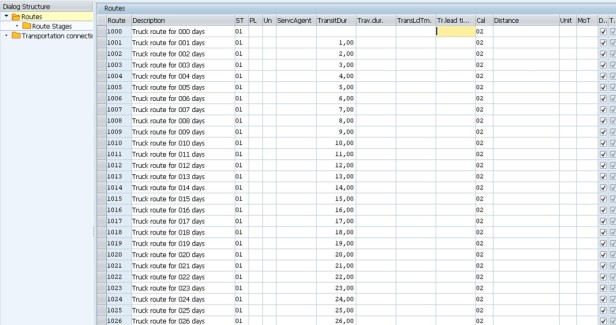

Maintain Stages for all Routes
You can process stages for several routes at the same time. So, instead doing it one by one, use the transaction or path below to maintain it in a more efficient way.
| TCODE | 0VTE |
| Path | SPRO > Logistics Execution > Shipping > Basic Shipping Functions > Routes > Define Routes > Maintain Stages for all Routes |
| Table/View | |
In the example below, I selected 3 route stages (selecting the checkbox) and I click in the “change” icon (the pencil). SAP pops-up the “attribute proposal for selected route stages” and whatever you maintain in there, it is going to be maintained to all the selected stages, lights will change from red to yellow. Then you need to “Save” and the lights will change from yellow to Green to confirm the modification.

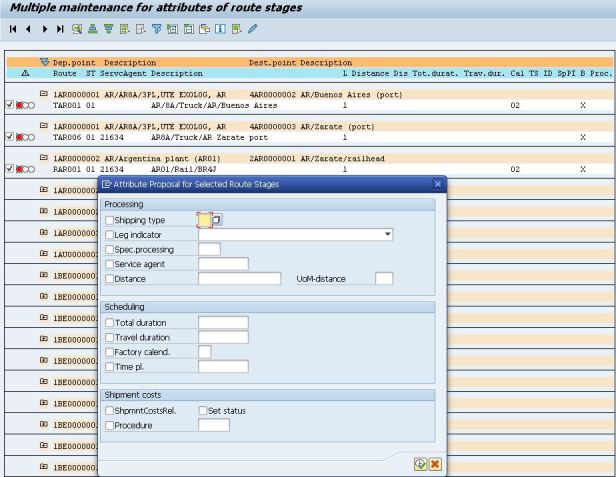
Determining Routes
To the route be automatically determined, the following parameters are taken in consideration:
- Country and departure zone (Shipping Point address)
- Country and destination zone (ship-to party address)
- Shipping condition (It is informed in the Sales Order and carried over to the subsequent documents)
- Transportation group (from the material master)
In the deliveries routes determination, you can also add weight groups to the list of controlling factors, if you are using weight as a criteria for routes determination, which is optional as explained more above.
| TCODE | 0VRF |
| Path | SPRO > Logistics Execution > Shipping > Basic Shipping Functions > Routes > Route Determination > Maintain Route Determination |
| Table/View | VC_TROLZ |
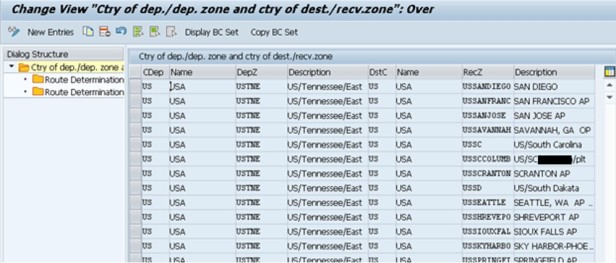

If you are using weight as a criteria to determine the route (as explained more above) here is where you will enter the weight group that you created, so to this combination of 4 elements explained above + the weight of the delivery, the route will be determined automatically.
Route Determination in Sales Order
The route is automatically pulled to the Sales document according to the combination below:
1. Departure zone or country of the shipping plant
2. Destination zone or country of the Ship-to-Party/Customer.
3. Shipping condition from Customer master.
4. Transportation Group from Material master.
5. Weight Group (if in use)
The route can also be manually entered or overwritten when you create or change a Sales Order document and also it can be re-determined in the Delivery document based on weight (weight group) if you are using the weight as a criteria (explained more above).
Scheduling and Delivery dates takes into account the following times: Transit Time / Loading Time / Pick/Pack Time /Transportation Lead/Planning Time.
Configuration of Shipments
See below what is required to configure the Shipment.
Maintain Transportation Relevance
Before configuring shipment documents, it is necessary to select the relevance to transportation.
| TCODE | 0VTR |
| Path | SPRO > Logistics Execution > Transportation > Shipments > Maintain Transportation Relevance |
| Table/View | V_TVLK_TR / V_TVLP_TL / V_TVRO |
- Delivery Type (V_TVLK_TR)
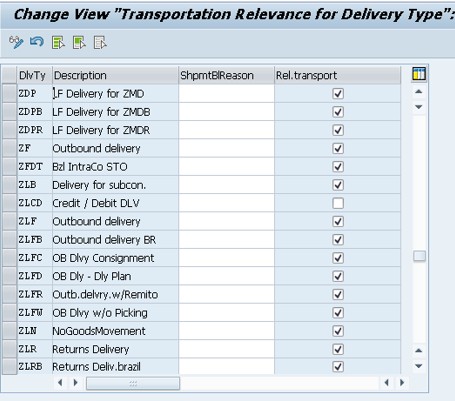
- Delivery Item Type (V_TVLP_TL)
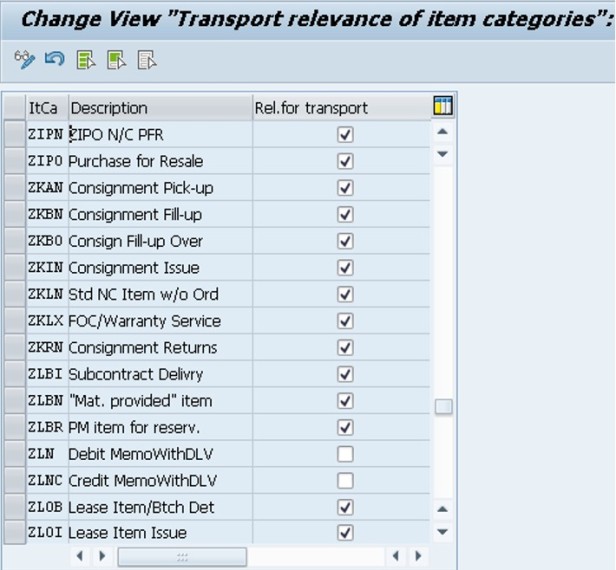
- Route (V_TVRO)

Set Up Transportation Planning Points
Once the transportation relevance is defined, you will need to configure the organizational structure that will run after transportation, for example, the shipment documents are created using the transportation planning point (which is tied to other organizational elements, such as shipping points, plants and etc.)
Define Shipment Type
The shipment types are related to the different ways of transporting and processing products, either from sales or stock transfer orders and etc. There are even situations where a Shipment Type for “Inbound” processing is required, for goods coming in.
There are 3 distinct transportation categories::
- The Individual shipment when one or more delivery documents are assigned and transported by a single transport mode from a departure point to a destination point.
- The Collective shipment where one or multiple deliveries are transported by one single transport mode from one or more departure points to one or more destination points.
- The Multi-modal shipment when deliveries are transported by several different transport modes between one or more departure points and one or more destination points.
| TCODE | OVTK |
| Path | SPRO > Logistics Execution > Transportation > Shipments > Define Shipment Types |
| Table/View | V_TVTK |

Here I will discuss some of the main fields:
Number Systems: It is where you maintain internal or external number range assignment that will be used when documents are created.
Document Content: This section is where the core of the Shipment Type’s configuration is. It is like the Shipment’s identity. See below some of the fields and what they mean.
- Shipment Completion Type: Identify the type of the shipment, if this is an inbound or outbound shipment, if it is loaded or empty.
- Shipping Type: This identifies if the shipment is road, air, ocean, rail or any other means of transport you have created in your system.
- Process Control: Identifies how the shipment type will be performed, if it is individual shipment or collective shipment, single mode of transport or multiple mode.
- Leg Indicator: The leg or stage is the representation of two transportation connection points or a single connection point where a transportation is performed (for example customs borders, loading transfer point). To each leg in a route it is possible to define the section type that this leg belongs, that can be a transportation, load transfer point or customs borders. It is also possible to identify if the leg is primary leg, main leg, subsequent, direct or a return leg. In a direct leg shipment type for example, the process will be performed in a single shipment but if it is a primary leg, main leg or subsequent leg, it will have more than one shipment connected to the delivery and the shipments will be linked to each other. And that’s where you can use theShTypePrelimLeg and SubseqLegShType to indicate the shipping type to those preliminary or subsequent legs.
- Determine Legs: A rule to assign the legs in a shipment can be defined here. Let’s say you pick 1: Legs Determined according To Departure Point & Itinerary in a collective shipment. Then the leg determination will be pulled to the shipment based on departures and destinations sequence

Transportation – Shipment Cost Document |
|---|
Before we move to the Shipment Cost Document (aka SCD or Shipment Cost) configuration, let’s briefly discuss the role that this document plays in Transportation.
The shipment Cost Document is created in reference to a Shipment Document where one or more stages are relevant for Shipment Costs.
When the Shipment Cost Document Item is assigned to an item category that is relevant for settlement, you can take advantage of additional features that includes freight cost calculation, accrual and invoice payments.
Usually, you have the freight rates agreed with your logistics service agents and those rates can be maintained upfront in the system and calculated using the pricing and conditions functionality. If rates are maintained in the system, they will be calculated regardless the item category been relevant for settlement or not, but with the item been relevant for settlement you can forward the shipment rates for FI/CO (GR/IR accrual, Cost elements assignments, purchase order and service entry sheet posting, Invoice verification and etc).
The reference to the shipment cost calculation is the shipment document, but the rates that are calculated based on the condition and pricing procedure are stored in the shipment cost document.
Shipment Cost Document Structure
The Shipment Cost Document is composed by: Header, Item and Sub-item.
- The header as you can imagine, contains data that is valid to the whole document and items, such as processing status, who created or changed the document, what is the document’s reference (the shipment number) and etc. The header also brings the Shipment Cost Document Type, which you can define to each type different processing rules and settlement procedures. See more below how to do that at Define Shipment Cost types section.
- The item(s) contain data required to the freight calculation like who is the service agent, the invoice presenter, the pricing date used for calculation, settlement date, item status and etc. See more below how to configure it atDefine Item Categories section. The items will refer to the header, of course, but they are also assigned to a specific Shipment’s stage. That helps for example when you have to charge certain costs that refers to the whole shipment or charges that refers only to a certain shipment leg (see section Assign Shipment Cost Type and item categories for more details).
- The sub-item(s) is where price is assigned. The sum or all sub-items will determine the total cost of the shipment. The cost is calculated via Condition Records using condition types. The condition types can vary their characteristics to cover your business needs, where you can define the calculation base per whole leg’s weight for example or based on the Handling Unit/Shipping Unit (pallets, trucks, container and etc.). You can also use scales to meet the prices agreed with your service agent.
Define Date Rules
Here you create “Date Rules”. They are used to determine what are the dates to be taken in consideration when a shipment is created, to the Pricing Date, Settlement Date. Since you may have different Shipment Item Types (Item Categories), they may have different rules to the dates, if so, you can create different rules here and assign them to the Shipment Item Type.The dates will come from Shipment’s deadlines dates (either actual or planned dates).
| TCODE | T_60 |
| Path | SPRO > Logistics Execution > Transportation > Shipments Costs > Basic Functions > Define Date Rules |
| Table/View | V_TVFTR |
Define and Assign Tariff Zones
Here is where you will inform the tariff zones along with their respective postal codes areas assigning to the tariff zones for each transportation planning point. You can use the Tariff Zones in the shipment cost calculation, based on a region (defined by a set of Postal Codes) assigned to a given Freight Agent.
| TCODE | T_76 |
| Path | SPRO > Logistics Execution > Transportation > Shipments Costs > Basic Functions > Define and Assign Tariff Zones |
| Table/View | TVFPTZ |
Define and Assign Activity Profile
The profiles are very useful to calculate shipment cost document during the sales order creation to allow have an estimated freight amount.
| TCODE | T_80 |
| Path | SPRO > Logistics Execution > Transportation > Shipments Costs > Define And Assign Activity Profiles |
| Table/View | V_TVTK_PROF |
Profiles are assigned based on Shipment Type and you can define different profiles depending on the Shipment’s status.

Define Shipment Cost types
In many businesses situations, it is common to have different needs for settlement procedures to the shipments. To handle those different needs, you can create different Shipment Types and assign them to their respective shipment types.
| TCODE | T_56 |
| Path | SPRO > Logistics Execution > Transportation > Shipments Costs > Shipment Cost Document > Shipment Cost Types and Item Categories |
| Table/View | V_TVTF |
The Shipment Cost type allows define what number range is going to be used, what is the status that the shipment’s deadlines needs to reach to allow the SCD creation. It is my personal suggestion that makes more sense to define that the Shipment must be in status 6 – Shipment Started, until a Shipment Cost Document can be created. That guarantees that the Freight document (SCD) will only be created if the Goods really left the plant. This last one is controlled via Ov.stat. Shipmt indicator.

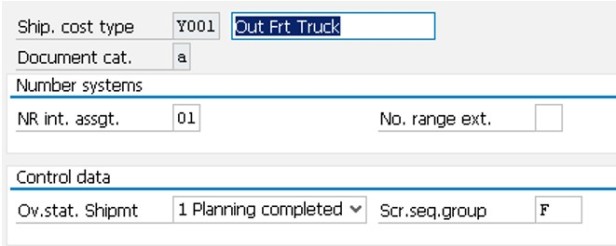
Define Item Categories
The Item Categories (shipment cost item types) contains settings for calculation and settlement of a shipment’s stage/leg.
| TCODE | T_56 |
| Path | SPRO > Logistics Execution > Transportation > Shipments Costs > Shipment Cost Document > Shipment Cost Types and Item Categories |
| Table/View | VC_TVFTK / V_TVTF / V_TVFT / V_TVFTK |
In the box Calculation you can define the Date Rules (see more above about date rules) that will be used to pick the pricing date. You will also be able to define a partner function that the item category will be allowed to use for and the item determination group, which plays an important role in the pricing automatic determination.
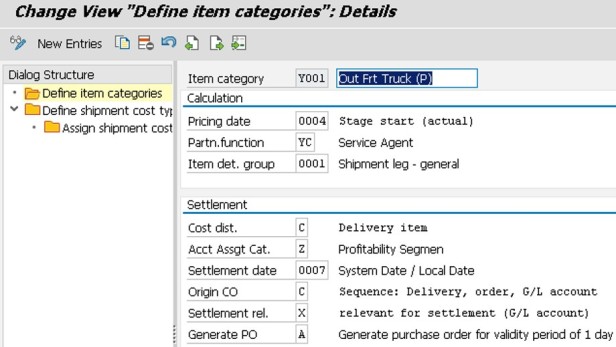
In the box Settlement you will see the following:
Cost Distribution > Cost distribution CO

This is to define in what level the cost distribution of shipment costs will be allocated during account assignment and document posting.
The following levels are possible to select:
- Shipment cost item
- Delivery
- Delivery item
You will be able to restrict the level of cost distribution using the field Origin of CO in this same configuration screen.
If you intend to use COPA (profitability analysis) it is important to know that the Cost distribution B (Delivery) or C(delivery item) must be selected, so the Profitability Object can pull the data from Delivery or Delivery Item, since the Shipment Cost (A) do not hold data that is used to the CO-PA Characteristics.
Account Assignment Category
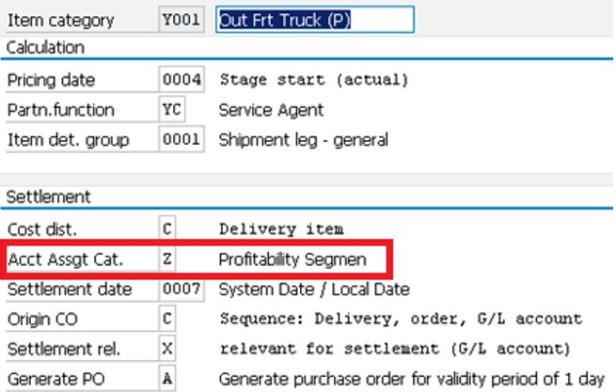
The account assignment category is the cost collector that will be used (for example:cost center, Profit Segment, Account Number and etc). Note that even if you use for example the Profitability Segment, the costs will still be posted “statistically” to cost center, and it will be available to read in the cost center’s reportS_ALR_87013611. The available options are:
- 9 Unknown
- A Asset
- B MTS prod./sales ord.
- C Sales order
- D Indiv.cust./project
- E Ind. cust. w. KD-CO
- F Order
- G MTS prod./project
- K Cost center
- M Ind. cust. w/o KD-CO
- N Network
- P Project
- Q Proj. make-to-order
- T All new aux.acc.
- U Unknown
- X All aux.acct.assgts.
- Z Profitability Segment
Settlement Date

Once again, check the Date Rules explained more above. Here you will assign one of the Date Rules you have created and this is the date that will be taken in consideration for “settlement” which is the accounting posting date (to the GR/IR accrual document)
Origin of CO assignments

The options that you can select for Origin of the CO assignments are: A – General ledger account, B – Sequence: Delivery, Sales Order or C – Sequence: Delivery, order, G/L account. In case you use profitability segment, it is recommended to select “C” so you can have the Sales Order and Delivery Document information flowing to CO-PA characteristics.
Relevant for settlement

Here is where you indicate if the shipment cost item is relevant or not for “settlement” (posting the GR/IR accrual). If you want to have the system creating PO’s automatically with subsequent GR/IR accruals, Service Entry Sheet, all behind the scene, automatically, you must select X here.
Purchase Order Generation

At the time that the shipment cost is posted (transferred), SAP can create a PO (or assign an existing PO depending on the configuration). Here are the options you can select: Field in Blank – Do not generate purchase order / A – Generate purchase order for validity period of 1 day / B – Generate purchase order for validity period of 1 week / C – Generate purchase order for validity period of 1 month.
Item Categories
Create as many as you need or use the standard delivered. Here is one example of what I had to do:
- YE01 Add cost Outbnd
- YO01 Out Frt Truck
- YO02 Out Frt Rail
- YO03 Out Frt InlndWter
- YO04 Out Frt Ocean
- YO05 Out Frt Air Cargo
- YO06 Out Frt Air Pssng
- YO07 Out Frt Others
- Y002 General costs
- Y003 Insurance
- Y004 Cleaning
- Y005 Load transfer
- Y006 Customs
- YFOR Forwarder Cost
- YIAD Inbound Add Csts
- YINB Inbound Frt Csts
- YINT Interco. Freight
Assign Shipment Cost Type and item categories
| TCODE | T_56 |
| Path | SPRO > Logistics Execution > Transportation > Shipments Costs > Shipment Cost Document > Shipment Cost Types and Item Categories |
| Table/View | V_TVFTK |

To each Shipment Cost Type, you need to do the proper assignments of Item Categories to specify when and how those item types will be pulled into the Shipment Cost Document. You also assign the Valuation Class, which plays an important role in the G/L account determination.
The Rec.indic. is directly tied to the stage type (in the shipment) and depending on the stage type (if it is based on Shipment Header, Shipment Leg, Load Transfer point and etc.) you assign what is the correct Item Type/Item Category to be used in the shipment cost document.
You can also select if to that shipment type, a given item category will be automatically assigned or if manual assignment is allowed, or even if the item category can shows twice in the same document.
Maintain Shipment cost relevance and default for shipment cost type
| TCODE | SPRO |
| Path | SPRO > Logistics Execution > Transportation > Shipments Costs > Shipment Cost Document > Shipment Cost Relevance and Default for Shipment Cost |
| Table/View | VC_TVTK_VF |
Here is where you will assign the shipment cost types to the respective shipment types:
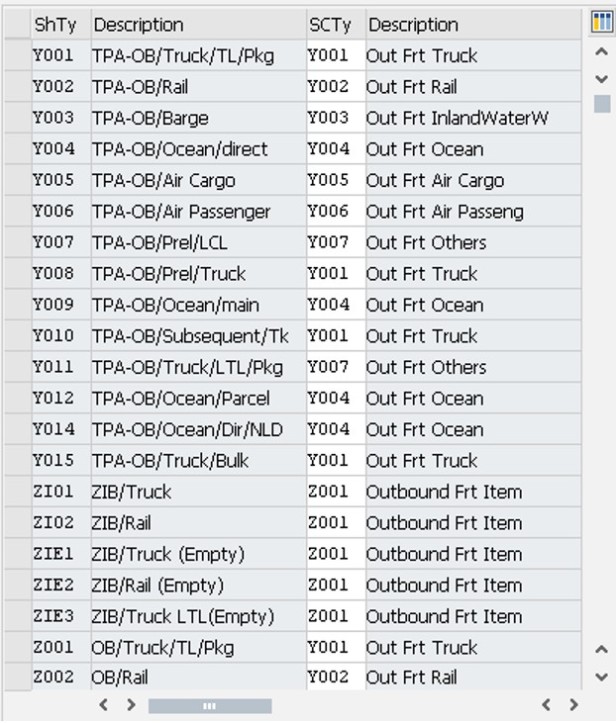

Define shipment cost relevance for shipment type
| TCODE | T_57 |
| Path | SPRO > Logistics Execution > Transportation > Shipments Costs > Shipment Cost Document > Shipment Cost Relevance and Default for Shipment Cost |
| Table/View | VC_TVTK_VF |
In this configuration you will indicate in what level the shipment cost needs to be calculated.For example, if to a given shipment type you select “leg” that indicates that the shipment stage is relevant for shipment costing but not the shipment header. You can’t “post” your shipment cost document to be ready to finance if the Shipment type is not relevant for shipment cost.

Pricing
Before you create a SCD, you must have the pricing procedures assignment with their respective set of conditions and to have rates maintained for those conditions. If rates are not maintained, the document will still be created (with 0.00 amount) but not transferred/posted. The whole Shipment cost calculation is based on the SAP Condition Technique. The Picture below shows how the Condition Technique operates.

The condition technique, condition types, scales, pricing procedures and their main characteristics follows the same concept of pricing procedure for other SAP documents. We will not spend much time here on this topic as there are many other sources for that. Later I will work on some examples and explanation for this topic and update it here.
Define and assign shipping type procedure group
Here you will define the Shipping type procedure group which is associated to the Shipping Type (represented mostly as the Mode of Transport). The shipping type procedure group is important to determine the pricing procedure automatically that will be used to calculate freight when shipment cost document is created.
| TCODE | T_72 / T_08 |
| Path | SPRO > Logistics Execution > Transportation > Shipments Costs > Pricing > Pricing Control > Define and Assign Pricing Procedures |
| Table/View | VC_TVFCV |
See below the relevant settings:
- VC_TVFCV – Define and assign shipping type procedure group (T_72)


Define and assign item procedure group
When you create a Shipment Item Type (Item Categories), you have to assign an item procedure group. Here is where you create those item procedure groups, which are also used to pricing procedure automatic determination.
| TCODE | T_71 |
| Path | SPRO > Logistics Execution > Transportation > Shipments Costs > Pricing > Pricing Control > Define and Assign Pricing Procedures |
| Table/View | VC_TVFT_Z |
- VC_TVFT_Z – Define and assign item procedure groups (T_71)
- This comes from item category group (Item type).
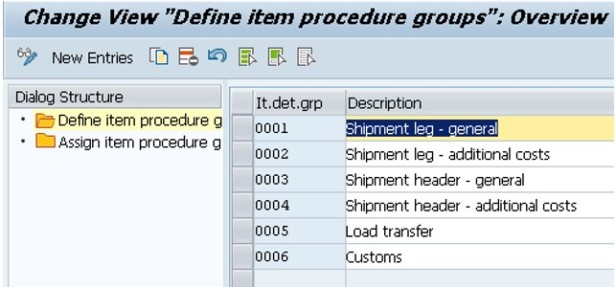

Define Service Agent Procedure Group for Shipment Costs
This is one additional element that you can use in Pricing’s automatically determination. The Service agent procedure group, as you can imagine, is informed in the Freight Agent Vendor Master in the control tab (XK01).
| TCODE | SPRO |
| Path | SPRO > Logistics Execution > Transportation > Shipments Costs > Pricing > Pricing Control > Define and Assign Pricing Procedures |
| Table/View | V_TVFCD |
- V_TVFCD – Service Agent Procedure Group for Shipment Costs
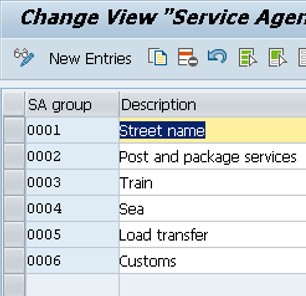
Maintain Price Procedure
To those are familiar with the Pricing Procedure concept (in Sales Order and Purchase Orders for example), the Shipment pricing procedure is the same as the standard pricing procedure and uses Conditions and Access Sequence to retrieve the data from condition records (entered for example via TK11).
| TCODE | SPRO |
| Path | SPRO > Logistics Execution > Transportation > Shipments Costs > Pricing > Pricing Control > Define and Assign Pricing Procedures |
| Table/View | VVC_T683_FA |
- VVC_T683_FA – Procedures

Define Pricing Procedure Determination for Shipment Costs
Based on the combination of Item Category Determination group, Service Agent Procedure Group, Shipping Type Procedure Group you can have the pricing procedure automatically determined in the Shipment Cost Document. It is not possible to manually enter a procedure in the Shipment Cost.
| TCODE | T_73 |
| Path | SPRO > Logistics Execution > Transportation > Shipments Costs > Pricing > Pricing Control > Define and Assign Pricing Procedures |
| Table/View | VC_TVFCSF |
- VC_TVFCSF – Determine Price Procedure (T_73)

The criteria on which the determination of the price procedure is assigned depends on:
- Transportation Planning Point – Shipment Header
- Item Group – Based on the SCD’s Item Category
- Service Agent Group – Service Agent Master Records
- Shipping Type Group – Based on Shipping Type

Maintain Condition Type
The condition type needs to be “E” if you want to calculate the freight based on net weight or D for Gross Weight based on Delivery’s weight.
| TCODE | T_06 |
| Path | SPRO > Logistics Execution > Transportation > Shipments Costs > Pricing > Pricing Control > Define Condition Type |
| Table/View | V_T685A |
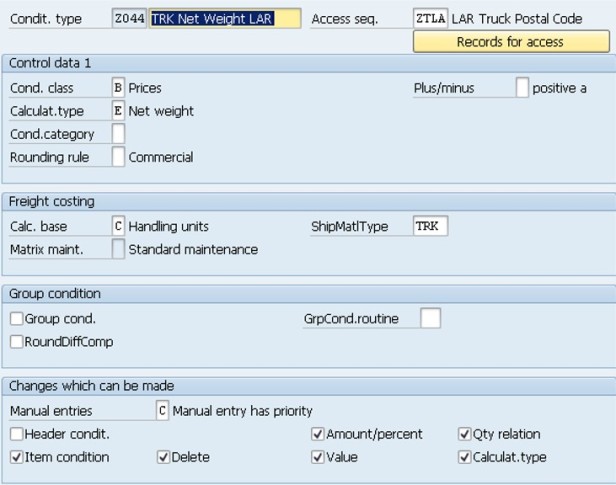

Settlement
As the Settlement triggers in most of the cases a Purchase Order and Service Entry Sheet creation, it is necessary to maintain some assignments, such as Purchase Organization, Purchase Group and Plant to a given Transportation Planning Point and Shipment Type.
| TCODE | T_53 |
| Path | SPRO > Logistics Execution > Transportation > Shipments Costs > Settlement > Assign Purchasing Data |
| Table/View | V_TVFP |

Account Determination
Group Together Valuation Areas
The account determination is based on valuation area and company codes. This is in most of the companies a FI job, not SD. For this reason, I will show it high level only.
| TCODE | OMWD |
| Path | SPRO > Materials Management > Valuation and Account Assignment > Account Determination > Group Together Valuation |
| Table/View | V_001K_K |
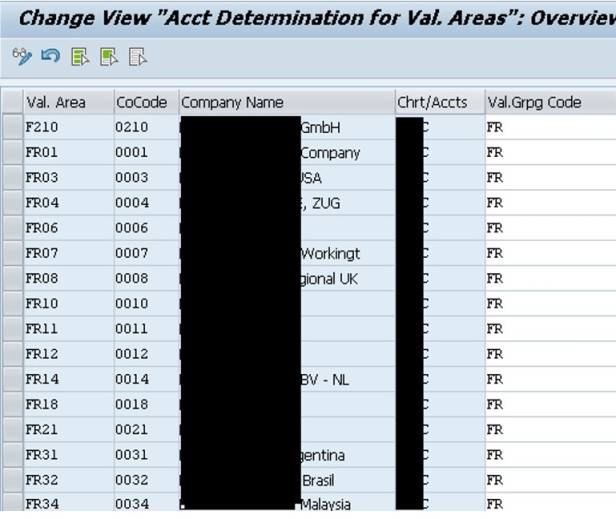
Define Valuation Classes
Here is where you create and assign valuation classes. The valuation class is assigned when you do the assignments of Shipment Type and Item Category (explained here previously).
| TCODE | OMSK |
| Path | SPRO > Materials Management > Valuation and Account Assignment > Account Determination > Define Valuation Classes |
| Table/View | V_025K / V025 / V_134_K |
- V_025K – Account Category Reference
Create account category references under account category reference

- V025 – Valuation Classes
Under valuation class, define the valuation classes for each account category reference.
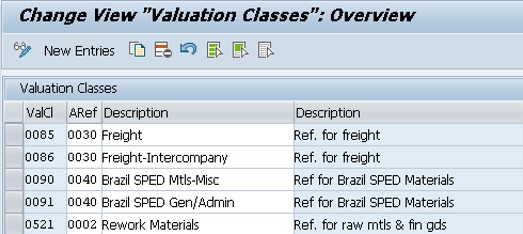
- V_134_K – Account Category Reference/Material Type
Under Material type/account category reference, assign an account category reference to each material type.
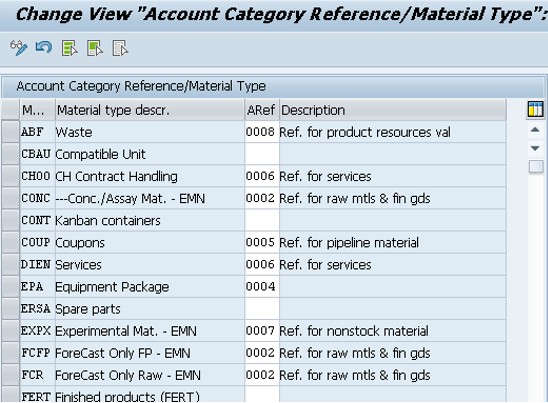
Automatic G/L account Determination
From the Transaction “GBB” and combination of General Modification key “VBR” and valuation class the G/L account is determined for the posting to the freight accounts.
| TCODE | OMWB |
| Path | SPRO > Logistics Execution > Transportation > Shipment Costs > Settlement > Automatic G/L Account Determination |
| Table/View |

From the Transaction “WRX” and value of valuation class as the G/L account is picked for GR/IR accounts.

Automatic determination of CO assignments
When the shipment cost document is created, the G/L account is pulled in based on configuration above, including valuation class. But how is the cost center assigned in the document? Remember that I said that even if you don’t use the cost center as primary account assignment, it is still used to post statistically.
So, based on the configuration below, the Cost Center is going to be pulled to the document and used in the accounting posting (accrual).
| TCODE | OKB9 |
| Path | SPRO > Logistics Execution > Transportation > Shipment Costs > Settlement > Automatic Determination of CO Assignments |
| Table/View |
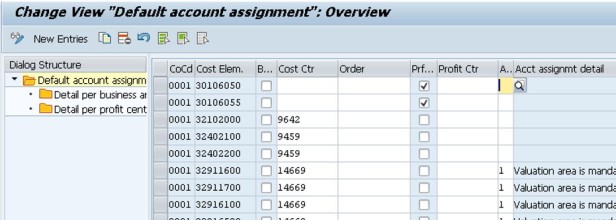
Business Process Procedure
Create transportation condition records
Here you maintain the rates agreed with the Freight Agent. This step is required in order to capture the cost / freight calculation automatically when the Shipment Cost Document is created.
| TCODE | TK11 |
| Path | SAP Easy Access > Logistics > Master data > Transportation > Shipment cost > Price |
| Table/View |
Create Delivery Document
With reference the sales order, you should create a delivery and pick the goods. This document is required as it is the source document to the Shipment Creation. You can use VL01N for example or collectively via VL10B.
Create Shipment Document
After the status of the delivery is open for transportation planning, it is possible to create a shipment document to schedule the transportation.
Create a shipment using transaction VT01N.
You will need to inform the Service Agent (in some cases it can come automatically from the route as explained previously).
Make sure your Delivery is posted for goods issue and your shipment is “shipment start” before you go to the next step.
Creating Shipment Cost Document & Cost Settlement
Call transaction VI01, type the Shipment Number and press Enter:

Then a screen like the one below will show and all you need to do it Save.
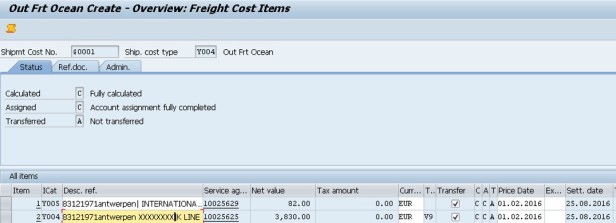
If all was okay (a rate was found, G/L account and others accounts assignment were okay), the document will be automatically posted (accrual, GR/IR, ready for Finance pay the invoice).
Use VI03 transaction to display. Enter shipment cost no. and press enter.
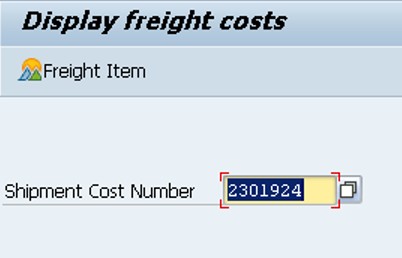
Note that the status of this document’s header is C C C, indicating that the document was calculated, account assignment was found and document was transferred (posted and ready to finance):
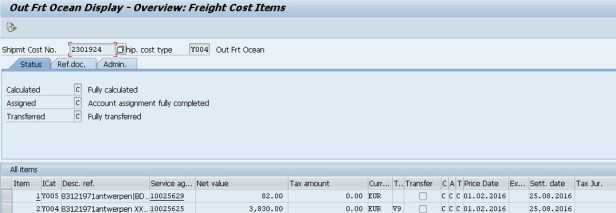
Effects of Shipment cost settlement and related documents
After the shipment cost settled in shipment cost document, it has the following affects:
- It creates a service entry sheet that refers to the purchase order determined.
- It posts acceptance of services performed.
- It creates an accounting document for the accruals.
- Further subsequent documents are created in FI.
User-Exits
V54B0001 Shipment Costing: Configure pricing
V54B0003 Shipment Costs Calculation: Determine Rate Type and Currency
V54B0004 Shipment Costs Calculation: Determine Status
V54C0001 Shipment Costing: Description(s) shipment cost item(s)
V54C0002 Shipment Costing: Create shipment cost sub-items
V54C0003 Shipment Costs Processing: Determine Invoicing Party
V54C0004 Shipment Costs Processing: Determine Loc. for Tax Invoice
V54D0001 Shipment Costing: Determining the Tax Countries
V54KSFRC Determining the factors for apportionment of shipment costs
V54P0001 Extended Function Codes for Shipment Cost Information
V54U0001 Shipment Cost processing: Check whether changes made
V54U0002 Check shipment costs for completion
V54U0003 Specification of shipment cost number
V54U0004 Formatting for update of new objects (shipment costs)
V54U0005 Updating new objects in shipment cost processing
V54U0006 Shipment Purchase Order – Header Data Supply
V54U0007 Shipment Purchase Order – Item Data Supply
BADIs
BADI_SCD_ACCTG Call During Shipment Cost Account Assignment
BADI_SCD_CREATE When Generating a Shipment Costs Document
BADI_SCD_CREATE_CHCK For Checks When Creating a Shipment Costs Document
BADI_SCD_PO_SELECT Call for the Purchase Order Item Determination
BADI_SCD_PROCESS_CHK For Checks During Shipment Costs Processing
BADI_SCD_SAVE When Saving Shipment Costs Documents
BADI_SCD_TRANSFER For Transferring Shipment Cost Items
That’s it, I hope it helps you…


Really detailed and useful information,i appreciate the efforts.
Kindly let me know how freight is transferred from Shipment Cost document to SD delivery note for billing same freight cost to customer.Rest processes are clear.
.
LikeLike
Hi Raj
Check the 2 documents below:
http://scn.sap.com/docs/DOC-53448
http://scn.sap.com/docs/DOC-57399
I hope it helps!
LikeLike
Thanks for the Detailed Document.
LikeLiked by 1 person
You are very welcome Tushar! Thanks for stopping by and leaving a comment! Good Luck!
LikeLike
Awesome document….very useful….Thanks Leandropia
LikeLiked by 1 person
Thank you very much for the document!
Could you please clarify my query?
During shipment cost document creation GL account is picked automatically but cost center is not filled during creation.
I have maintained, OMWB and OKB9 settings but still in Assigned tab is having B (partially completed) instead C.
Could you please suggest some work around?
Thanks,
Ramya
LikeLike
How many items do you have in the Shipment Cost Document? If more than 1, it is all of them getting the B status? If one of the items is getting the account assigment as C and the other as B, can you spot what is the difference between them? The account assignment, if you don’t have any change in the SCD_ACCT badi it is straight and forward, I mean, if the GL account is found, it looks on OKB9 and bring the CC from there.
LikeLike
How this will work for PO cycle and inbound delivery. Can you share a document :
PO (Vendor A)- INBOUND DELIVERY- SHIPMENT DOCUMENT-SHIPMENT COST-AUTOMATIC SERVICE PO-
LikeLike
SERVICE PO WILL BE FOR VENDOR B
LikeLike
Are all types of material allowed? Even raw or semi-finished?
LikeLike
Michael, I didn’t get your point, could you please elaborate?
LikeLike